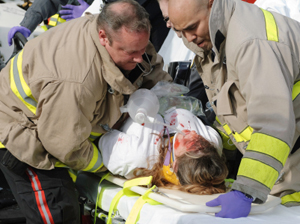 Last year I graduated from CERT (Community Emergency Response Team) class. In CERT you receive training on how to prepare, survive, and help out in a disaster, natural or otherwise. I took the class with a friend of mine, Dana Richardson, who had taken the class before and came to mine as a refresher. My motivation for becoming trained was so that I could prepare for a natural disaster, protect my family, and also help my community in case of an emergency.
Last year I graduated from CERT (Community Emergency Response Team) class. In CERT you receive training on how to prepare, survive, and help out in a disaster, natural or otherwise. I took the class with a friend of mine, Dana Richardson, who had taken the class before and came to mine as a refresher. My motivation for becoming trained was so that I could prepare for a natural disaster, protect my family, and also help my community in case of an emergency.
You may remember the article I wrote, Cultivating Command and Leadership, where I detailed what happened during our final disaster simulation and how I ended up taking command of the entire team. It was the kind of experience that made me want to get even more involved in disaster preparation and mass casualty incident training.
When you graduate from CERT class, you are put in a system that notifies you if there is ever a disaster in your local community, so that you can respond to the scene and help out with medical triage, search and rescue, and even fire suppression. Periodically, Dana and I would receive notifications from the system about events and trainings being held in town that would enhance our training. But nothing terribly intense or interesting has happened since I graduated from CERT. Until recently that is! Dana and I received a notification that the North Las Vegas Fire Dept. needed volunteers to assist them in a Mass Casualty Incident drill. We would get to play accident victims, complete with bloody make-up and fake injuries, and more importantly, we’d get to watch how our actual fire and rescue crews handled themselves in the drill. I was giddy with excitement and signed us up to attend 2 out of the 6 incidences.
Here is an account of what happened to us during the drill and our thoughts about what we experienced. Dana is going to share his thoughts as well since we were in different positions both times.
The Briefing
All the participants were briefed on what was going to go down. We were to get our characters, go to make-up to get our fake injuries put in place, and be ready to go by 8:30pm. We were given a safe word to use in case we really got sick or injured during the simulation. If we said, “Real world” and then made a complaint, the rescue worker would know we needed real help. Otherwise, we were told, to really get into our characters so it would feel as real to the rescue workers as possible. I was looking forward to acting and hamming it up a little.
Dana’s Experience:
To be honest, it was your run of the mill briefing. Sign in, sign waiver, and wait for further instructions. They had pens with pink ink, which I found interesting as you don’t really expect to find pink pens at a manly firehouse.
The crowd was a mix of ages from 17-60. Lots of high school kids, some families, and what I would guess are future EMT / Firefighter trainees. Our CERT class had taught us that people would be ‘in character,’ acting out their injuries and really giving the firefighters a dramatic performance. Both times we attended the crowd didn’t appear to be of the actor type.
The head fireman in charge had a strong presence and was able to communicate effectively what was to go down that night. After our briefing, he assigned roles. Each “role” came with a write-up of the person, injury, vital signs etc. Erin and I were both a bit thrown off as the write-up was done in what I can only imagine is ‘Firespeak.’ Lots of shorthand, acronyms and codes we didn’t fully understand. Erin actually made a comment about this, and we were both impressed to see that at the second go-around, the severely injured characters had a plain-english write-up describing their injuries so they could act them out more accurately.
Getting into Make-Up
For our first simulation, I played a pedestrian who had been hit by a truck. I had a fib/tib deformity and upon examination they would discover I had internal injuries. I got make-up put on my leg, and then read my card over carefully to make sure I understood my role. Some of the abbreviations were hard to figure out so I asked a paramedic what LOC, CP, SOB, JVD, CC, and Ax0x4 meant. How could I play my part properly if I didn’t fully understand my symptoms? Those abbreviations stand for loss of consciousness, chest pain, shortness of breath, jugular vein distension, chief complaint, and alert and oriented x 4. Watching everyone get their make-up on was fun. Some people had fake bones sticking out of their extremities, and someone had their intestines protruding from their body. These were obviously the more critical patients!
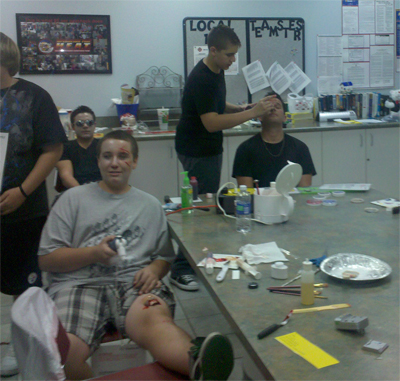
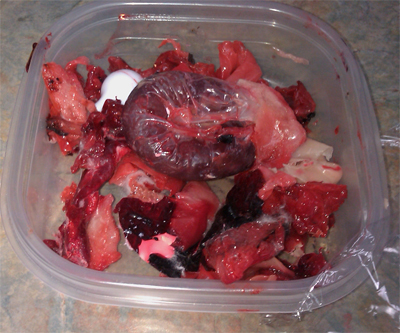
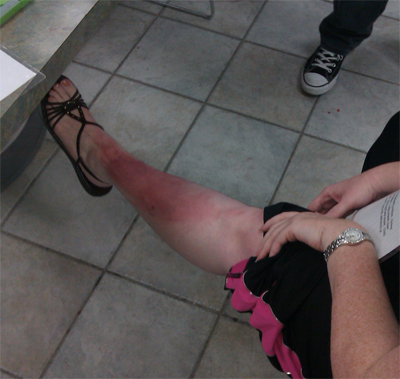

Dana’s experience:
My first injury was “Airbag Face.” I could only guess I was the person driving the truck that nailed Erin. 🙂 My injuries just required me to have a couple splotchy blood spots and chemical burns on my face and arms where my fictitious airbag hit me on impact. Other than that my injuries were fairly unremarkable, basically just some back pain. I remained conscious during the accident, and was well aware of what speed I was travelling at, and everything that happened.
My second injury wasn’t a big deal at all, only a dislocated shoulder from jumping onto a fence. All the make-up people had to do was create a couple good scratches etc. on my right arm.
The make-up people were a local indie film crew that was volunteering their services. I was really impressed with how they performed. They knew their injuries well, and had plenty of neat looking ‘accessories’ on hand to embellish wounds. Erin and I laughed that they likely have spent lots of time staring at nasty wounds and injuries to be as good as they were.

Getting into Position
The rescue workers were getting briefed while we were getting our make-up on. There must have been at least 50 of them. We were taken out to the scene of the accident. They were simulating a bus stop accident that involved 2 cars that were seriously munched, plus 5 trucks and vans that had also collided. A guy with a map started placing us in our positions. Since I was a pedestrian and had a broken leg, I had to lay on the ground between two trucks. It was a hundred degrees outside, and I was lying in dirt and gravel. Not comfortable, but I didn’t care, I was just excited to start playing!
Dana’s experience:
I lucked out. The first time I got to sit in a truck right next to the munched cars. Second time I played “walking wounded,” so no dirt and gravel ever touched my butt. 😉


Action!
A guy came by and said, “We’re live. Start acting.” We were told to really get into our characters and try to play them as true to life as possible. Fire trucks rolled onto the field with their lights going. I was wondering how they were going to see our cards in the dark, but they brought a crane in overhead with lights to illuminate the entire scene. I was so excited! I started moaning and complaining that I needed help. And then I waited. And waited. There must have been 40 or so wounded people on the field and about 30-35 rescue workers, so I assumed that someone would come by to triage me within a few minutes. But that didn’t happen. I had a limited view from my vantage point on the ground, sandwiched between two trucks, but it seemed as if most of the rescue workers went to the two munched cars to extract the badly injured in the vehicles.
After about 20 minutes, I decided to be more vocal. I grabbed a lady near me who was “walking wounded” and said, “Help me, please! My leg is killing me. Can you get a paramedic for me?” She said, “Are we allowed to do that?” I said, “Yeah, they told us in the briefing that it was okay to make a nuisance of ourselves because the guys had to get used to that too and learn how to handle people at a major accident scene.” She lit up, and started walking around yelling, “We need help over here! This lady is badly injured. She can’t move. Someone please help her!” A rescue worker came to me and said, “What seems to be your problem?” I replied, “My leg hurts really bad.” He took a cursory glance at the card hanging around my neck which shows my vital signs and injuries, and he put a tag around my wrist that said, “Delayed” meaning my injuries weren’t critical. He didn’t do the head to toe assessment that we were taught to do in CERT training. If he had, I would have reported tenderness and rigidity to the abdomen and he might have noticed I had internal bleeding.
So I waited some more. And some more. After lying on the ground for about 45 minutes, a guy came by with a backboard. He rolled me onto it and strapped my head in place and buckled all my extremities in. I felt very trapped and claustrophobic at that and started to wonder why I volunteered for this. Another guy came by to do my assessment. He asked if I could wiggle my toes, which I could. He checked for a pulse in my leg, which was good. He asked what happened to me and I said, “I was hit by a truck.” He seemed shocked and said to the other rescue worker, “She got hit by a truck and all she has is a broken leg? Are you sure?” The guy said, “Yeah I guess.” They both looked dubious about that, but assumed the original guy who tagged me had been thorough (he hadn’t). Just as they were getting ready to move me to the treatment area, another guy came by and said, “Why are you working on a delayed person? We have critically wounded people over there.” So they left me, lying on the board, in the most uncomfortable position I could be in. My lower back was starting to hurt for real.
Luckily, someone came by to check on me every few minutes. But I laid there for about 20 more minutes wondering what was happening since I couldn’t turn my head. It sucked.
Finally three guys came to take me away. At this point I realized they still had no idea that I had internal injuries so I started complaining that my stomach was hurting really bad. They asked if I needed to vomit and I said no, so they paid that no more attention. They put me on a gurney and wheeled me halfway to the triage area. The senior paramedic told the younger paramedic to stay with me in case I vomited, but the younger guy really wanted to get back into the fray. So after 30 seconds, he just up and left me. I was annoyed, and fake dying from internal injuries no one knew about yet. I grabbed my cell phone from my pocket and texted Dana, “Come find me and get me off this backboard!” He didn’t answer. I knew his injuries were light and figured he was roaming around somewhere. I was wrong.
Someone came by a short while later and said they needed the gurney and asked why I had been left all alone. No one had a good answer. So they took me off the gurney (still tied to the horrible backboard) and put me in the treatment area for triage. Now we were getting somewhere! They asked my name and if I remember the accident. I complained about pain in my leg and told them my stomach was now killing me. He looked at my card and then started slapping cards on my body to simulate treatments. I had cards that said IV hookup, blood pressure cuff, bandages, splint. I asked if I could please get up off the backboard and they said yes but told me to stay where I was because they had to simulate putting me in the ambulance. When I sat up, I saw that Dana had been lying next to me on a backboard of his own. No wonder he never answered me. He was trussed up like a Christmas turkey.
They took me to the ambulance where a senior paramedic stood waiting to receive me. He asked what was wrong with me, and they said, “possible fracture of the tib/fib, otherwise stable.” The senior paramedic looked at my card and actually read it all the way through. He said, “Did anyone notice that this woman has internal bleeding?” One replied, “Uh no, we thought she only had a broken leg.” He said, “Did you assess her?” They shook their heads. He said, “If you had, you would have noticed she has tenderness in her stomach and rigidity. She should have been labeled critical and transported a long time ago. She probably won’t live to see the hospital. She’s been out here, what, an hour and a half? Yeah, she’s probably dead.” The paramedics with me seemed really crestfallen. I felt sort of sorry for them, but I had tried to clue them in all along the way.
I was released, so I went to check on Dana who was just getting his assessment.
Dana’s experience:
For the first incident, I was sitting right next to the munched cars, and since my injuries were light, I was able to have a first-hand view of the extraction teams brace, chop and open up the munched cars.
That being said, I was a little disappointed with the ‘waiting’ as well. During the briefing the head guy mentioned there was going to be 18 or so teams working the scene. I imagined a barrage of fireman, triaging the entire scene in mere minutes. That wasn’t the case.
The extraction team was the first on scene, and they went directly to the munched cars, somewhat ignoring the rest of the scene. I’m not sure if they were instructed to do just that, but I would have assumed they’d triage everyone, or at least get an idea of what they were dealing with before grabbing their toys. I did hear someone yell for the walking wounded to come to the sound of their voice, but nobody else was really checking any of the people who may have been immediate, aka Erin lying squirming on the ground getting gravel in her backside.
So I sat and watched 7-10 fireman work together to chop up a car. They had all sorts of fun toys. Saws, braces, straps, jaws of life etc. It was an orgy of awesome tools. They peaked in the cars, smashed windows and starting wrecking metal with crowbars. I was a bit jealous. 🙂
There were two cars. One was an overturned Sedan, the other was a totally mashed up Van. Each of the two munched cars had dummies in them to simulate the wounded. Once they got the dummies out, the live actor would replace the dummy on the backboard for triage and assessment.
They started with the Sedan. It looked like they immediately staked down the front of the car. Then they braced and strapped the back of the car so that it would remain in the position they found it. From then on, they worked everything through the back window.
The van was worked a bit different. It seemed the first thing they did was crowbar into the engine area and disconnect the battery. Then, a fireman entered the van and sat in the middle seat, placing two blankets over the driver and passenger. I first assumed they were dead, but the fire team was just preparing them for the fun of what was about to happen. Out came the chainsaw.
They chopped the roof of the van off. It was pretty awesome. One thing to note when chopping off the roof of a van -Make sure there are no seat belts still attached to the van occupants – the simulated dummy passenger found this out the hard way.

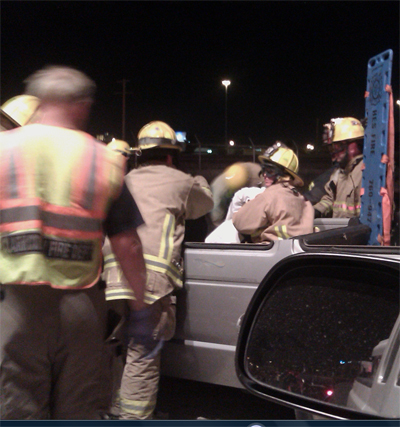
After about 20-30 minutes, and while the extraction team was chopping the van roof off, someone finally approached the vehicle I was in to see if we’d been talked to yet. My passenger had more “spooky” injuries than me, so they took him out first, and let me get back to watching the extraction team. They would come back for me later.
The driver of the van was wedged into the car. My best guess was that his left leg was smashed between metal and the steering column. Out came the Jaws of Life. I’ve never really given much thought to the strategy of using the Jaws of Life, but there’s definitely strategy to be learned in order to not aggravate the victim’s injuries. They bent and clamped the van in very odd places, but it seemed to release the victim’s leg. Impressive.
My primary injury, besides Airbag Face, was lower to mid back pain. When my rescuers finally came back for me, I made sure to act my part and let them know my back had an “owie.” Apparently I need acting school, because even with my pseudo back injury, they jerked me out of the driver’s seat and onto a board. I’m not sure if there’s a nicer way to do that to a person with a back injury, but it seemed a bit non-delicate. If I was more into character, I would have exaggerated my back pain, but the board immediately threw me into a real world panic.
The board sucked. I honestly felt like I was going to fall off to the left. I was strapped in, and being carried by 3 husky men, but felt like my right side was about a foot higher than my left. Being that my head was taped to it, I couldn’t quite tell why that was. Not sure if it was how they were carrying me, how I was positioned on it or what, but the whole time I was trying to shift my weight to avoid tumbling off that blasted thing.
Additionally, there’s really no “nice” way to set that board on the ground. If there’s any innovative readers out there, there’s probably a ton of money in re-engineering the back board. It needs help.
The assessment area for me was fairly unremarkable. Being that I didn’t really have any serious injuries there were no surprises for the medical assessment team like Erin had. I was just asked a bunch of questions about my injuries and then released. I was going to live!
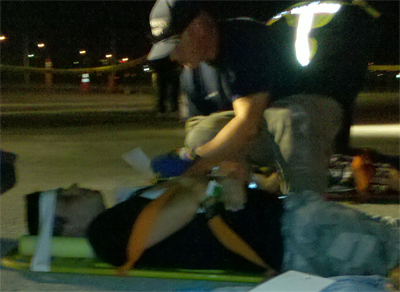
Assessment:
Once we were released, we started walking the scene and talking about our experience. We were both sort of shocked by a few things that happened.
First, from CERT class we were taught that everyone in the field needs to be triaged and tagged before anyone actually gets treated. This didn’t happen. It seemed as if they started at one end of the accident and slowly made their way to the other end. I wasn’t triaged or tagged for at least 30 minutes. Had I been critical I would have had very little time to get to a hospital for treatment.
Second, I was tagged incorrectly as “delayed” which means I could survive my wounds without getting treatment right away. This was not true as my character had internal bleeding. Just because a patient doesn’t complain about pain in an area doesn’t mean they aren’t injured in that area. If the paramedics had either read my card completely or done a head to toe assessment, they would have figured it out much sooner.
Third, once the first rescue worker tagged me as delayed no one else bothered to double check that. So even when one guy found out I’d been hit by a truck I could see the light go on in his head that I should be more injured than just a broken leg, but when he saw I’d been tagged as delayed he overrode his own critical thinking and decided I must be in the appropriate category.
And lastly, it was hard for us lay people to understand what the abbreviations and symbols on our cards were. I wrote a letter to the Captain outlining a few changes I wanted to see made to those cards so that we, the actors, could better play our roles.
Dana’s experience:
Ditto what Erin said.
I was both impressed and concerned with the slowness at which the teams moved. On the one hand, with that many injured people you want to get to them quickly, but on the other hand, they have to take it slow or they risk injuring themselves. In the real world version of our scenario, there’s likely debris, fluids and god knows what strewn about the scene.
To add to Erin’s concern about the wait time to get treated, neither her nor I were aware of what the rescuers instructions were. The extraction team may have been told just go straight to the munched cars. The actual triage teams might have purposely had a delayed start, or only assigned to certain vehicles. Our knowledge of what to do is limited to the CERT courses, we haven’t gone through professional training like the paramedics and rescue workers have.
Additionally, it was difficult to tell who was supervising and who was working. At one point while waiting in the truck, a fireman in a cool black fire suit came and talked to me. He seemed more official than the others scrambling about. I got the impression he was in gear, but simply overlooking the crews.
From the news coverage, all the fire crews that participated were on a volunteer basis – nobody was being paid to be there. Maybe they were volunteering for areas they felt they needed practice in, and being instructed / assigned as such.
I also was a little put off by how fast the rescuers went to my injury card instead of discerning what was wrong with me. My acting isn’t great, but I was hoping they’d do a little questioning before they grabbed the cheat sheet and started reading the answers.
Our Second Experience:
We went back a second time for another simulation. I was really surprised and happy to find that the captain had made some changes to the simulation cards so that it was much easier for us to understand how to play our roles. When it was time to get our roles I asked for a critically injured character so I could see the difference in treatment time. He gave me a character who was in the passenger seat of the van, (yay, no gravel and dirt!) had a head injury, abdominal pain, dizziness, and nausea. I had also lost my front teeth and had reopened an old foot injury. I was a mess.
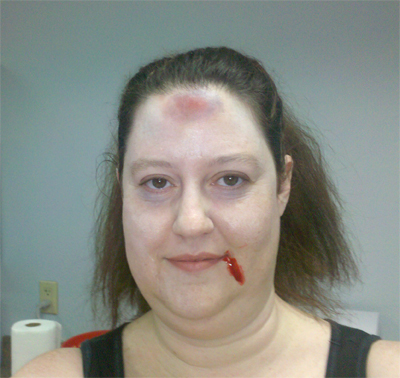
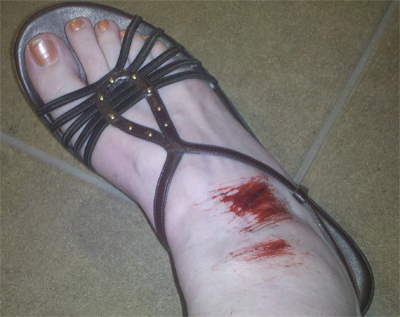

There are three triage assessment items. The first is capillary refill. When they squeeze a finger or toe your blood has to fill it back up within 2 seconds. Otherwise, you’re critical. The second is respirations. If you’re breathing less than 10 or more than 30 times in a minute, you’re critical. Both of those were okay for my character. But the third item is mental status. If a patient can’t recall the accident or is unconscious or confused, that is a critical item. My character card said I had lost consciousness at the scene and couldn’t remember the accident. I got in the van and was there with 4 other people. When they yelled action I couldn’t wait to see how long it would take them to do their initial assessment.
Unfortunately, a guy came by the van and said, “How you all doing in there? Everyone okay?” I don’t think you should let the patient tell you whether they’re okay or not. How would they know for sure? They could be in shock! So the rest of the van passengers vocalized their chief complaint “My ankle hurts. My wrist hurst. My back hurts, etc.” I looked dazed, confused, and my head was lolling around. He didn’t notice, and no one in my van spoke on my behalf. The guy left us to move on to more critically injured people.
After 10-15 minutes I said, “This sucks. We weren’t assessed or tagged. And I have critical wounds. I’m probably gonna die in here waiting for them.” So the lady in the back seat said, “Oh no you won’t. We’re gonna get you help!” Then she started being super vocal (I loved this woman!). “Hey, hello, excuse me! We need help in here! Our friend is horribly wounded, she lost consciousness, she’s not BREATHING!” Okay, I was breathing, but I appreciated her efforts on my behalf. So a guy came by and said, “What’s going on in here?” She told him I was severely wounded. That’s when he looked at my card for the first time. He asked, “Do you know where you are?” I said, “Uh, Narnia?” He laughed a little. Then said, “Do you remember the accident?” I said, “Was I in an accident?” Doing everything I could to portray mental impairment so he’d get the clue. He said, “You’re alright. Just hang tight. We’ll get someone here soon.” I held out my teeth and said, “I think these are my teeth.” He said, “Ewww, uh just hang on to those for now.”
Just a few minutes later three guys came and dumped me out onto a backboard lickety split. This time I was put on a gurney right away and they didn’t strap my head down due to my head injury being in the way. Before I knew it, though, I found myself put into an actual ambulance! I protested. “Wait, I’m a simulated transport. I’m not going to the hospital” which is where they were taking most of the critically wounded people so the doctors at the hospital could practice too. The paramedic replied, “Oh yeah, you’re going.” I said, “No wait, I can’t go to the hospital. I got people waiting for me. I’m paying a sitter by the hour. Please don’t take me.” He said, “Oh, well, alright, let me find out if we’re taking you or not.” When he came back he said they weren’t taking me, but just then someone got in the front of the ambulance and started up the truck. I said, “Does THAT guy know we’re not going!?!?!” They told him to turn off the truck.
So now we’re sitting in an air-conditioned vehicle (ahhhh) and they do their assessment. The senior paramedic asks the younger guy to assess me. He missed my critical injuries on the basic three item triage assessment. So the senior paramedic explained to him that mental impairment is indicative of a brain injury which puts me in the critical or immediate category. I mean, I learned this in CERT class and I’m not a trained professional. Why don’t the paramedics know this?
I was taken to the triage treatment area, assessed properly this time, and sent on my way.
Dana’s experience:
Before I start, I just want to say Erin’s knocked out teeth were amazing. Bloody Tic Tacs in gauze… She made tons of friends with the busted teeth too. Probably one of the best conversation starters ever. 🙂
Anyways, since I got to be so close to all the action last time, I wanted an overview position this time. I volunteered for walking wounded, which would get me off the scene immediately, and into an area where I could watch everything. Mission accomplished.
When the first team arrived, they yelled out the “If you can walk, come to the sound of my voice” order. I happily obliged and followed the fireman off the scene like an obedient little puppy dog.
There were two areas where they kept the walking wounded. The first position was just a little bit away from the scene. I got to see a triage team of firefighters working the scene, tagging people. They seemed to be working faster than the first group we experienced.
After that, they corralled us walking wounded near a vehicle that I assume was the Command Center. Two veteran looking guys sat in an SUV with laptops, phones, CBs taking plenty of notes. Very official looking. Every now and then a firefighter would approach the SUV and wait for one of the veteran guys to roll down the window before talking with them. The two guys in the truck, while sitting next to each other, never seemed to talk amongst themselves. Both were constantly on a communication device, writing down notes.
I also got to see how they position the ambulances. I never thought about it, but I suppose there’s a benefit to not have your transport vehicles parked all willy-nilly. The ambulances were lined up, parallel to each other, ready for a fast get-a-way. The Ambulances were also distanced enough that the ambulance in back could sneak between if it left before the vehicles in front of it.
Both times there was a planned Helicopter landing and medical evac for one lucky volunteer. The first time the landing got nixed because President Obama was in town, the second time however – we got it.
The helicopter came in fairly low, maybe 300 feet off deck, circled and kicked on the flood light to survey the scene. As it landed, two EMT’s jumped out and casually walked over to the medical assessment area. After a minute or so, I saw the evac’ee being carried over to the helicopter. The pilot flipped back on the flood light to give them adequate lighting to approach the helo. When the two EMTs saw their patient approaching, they proceeded back over to the helicopter to receive their new passenger. The hand-off seemed very quick, and within minutes the helicopter disappeared into the night.
Then I recognized Erin being rolled into an ambulance. I knew what her injuries were, and I knew she was a ‘simulated’ transport… meaning she shouldn’t be getting into any ambulances. Right after they put her in the ambulance, the ambulance next to her sped off with a transport. It definitely appeared Erin was going for a ride that night. Nonetheless, I’m a pretty resourceful guy and I had her car keys so I wasn’t too worried if they did take her away. 😉
I also got to see my friend “The Back Board” in action, and maybe gained some more clarity into why it’s now a nemesis of mine. They were carrying a guy out who was about my size and the thing looked more like a hammock than a board. There was a definite U-shape happening. When he was released I overheard him laughing about “feeling like he was going to fall off the thing.” Coincidence?
What we learned
I had a blast playing in the simulation and would definitely do it again. I know it must be hard to coordinate so many units and people. I was somewhat disappointed by the level of skill of the paramedics and hope they are getting properly trained. I think Dana and I both left the simulation deciding under no circumstances did we ever want to be in a car accident in Las Vegas. But we know it was a training drill and I’m sure the senior paramedics and firefighters in charge did their best to educate and debrief their younglings after the drill.
Dana’s Experience:
Pretty much what Erin said. It was a lot of fun, but not as intense and satisfying as I thought it would be. If you ever come to Vegas, try not to be in a multiple car / bus-station accident.
If you want to find a CERT class in your area (they’re all free!) go here.

